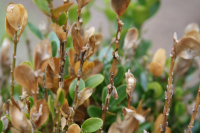
Boxwood Blight is a disease caused by the fungus Calonectria pseudonaviculata. It was first discovered in Georgia in 2013. The fungus can be spread by numerous means including splashing from rain drops, contact with clothes, shoes, animals, and pruning equipment. Using proper sanitation practices when working around boxwoods and proper disposal of infected plants is crucial to help prevent and control the spread of this pest. No curative treatment for the pathogen has been found. There are fungicides that can be used through repeated applications as a preventative measure to help protect non infected boxwood plants. The disease causes severe symptoms including leaf spots, leaf drop, and black stem lesions. Below are some are some examples of symptoms associated with Boxwood Blight.
Boxwood Blight is not a quarantined pest; however, due to the threat of this disease, several nurseries have elected to participate in a voluntary compliance program that is administered by the GDA Plant Protection Section.
The following nurseries are participating in the GDA Boxwood Blight Compliance Program
- Mid Georgia Nursery
- Griffith Propagation Nursery
- R. A. Dudley Nurseries
- McCorkle Nurseries
- Monrovia Growers of Georgia
- Topiary Courtyard
- Harp's Farm and Market
Compliance program participants agree to follow best management practices specifically developed to help prevent and control this very damaging disease. However, the compliance program does not guarantee freedom from Boxwood Blight. When entering into a boxwood blight compliance agreement, the production nursery agrees to adhere to the ANLA Nursery Industry Voluntary Best Management Practices** for Cylindrocladium pseudonaviculatum (Boxwood Blight) as well as the following:
- A. Out sourced plant material should be obtained from nurseries who are participating in a Boxwood Blight Compliance Program.
- Plant material originating from a nursery who is not participating in a Boxwood Blight Compliance Program must be held in an isolated area, untreated for 30 days and inspected and found free from symptoms of boxwood blight before shipment.
- Isolated host plants must be held at least 10 meters from other host plants.
- Plant debris will be removed on a regular basis.
- Watering will be done in such a manner as to allow the foliage to dry before dark.
- No host material of boxwood blight will be composted.
- Each holding area will be thoroughly cleaned and treated with an approved treatment after each crop.
The following are some helpful links to more information regarding boxwood blight:
UGA Disease Update: Boxwood Blight in Georgia
Virginia Tech Boxwood Blight Task Force Page
NC State University: Prevention and Management of Boxwood Blight


